Biermann Ch. Handbook of Pulping and Papermaking
Подождите немного. Документ загружается.

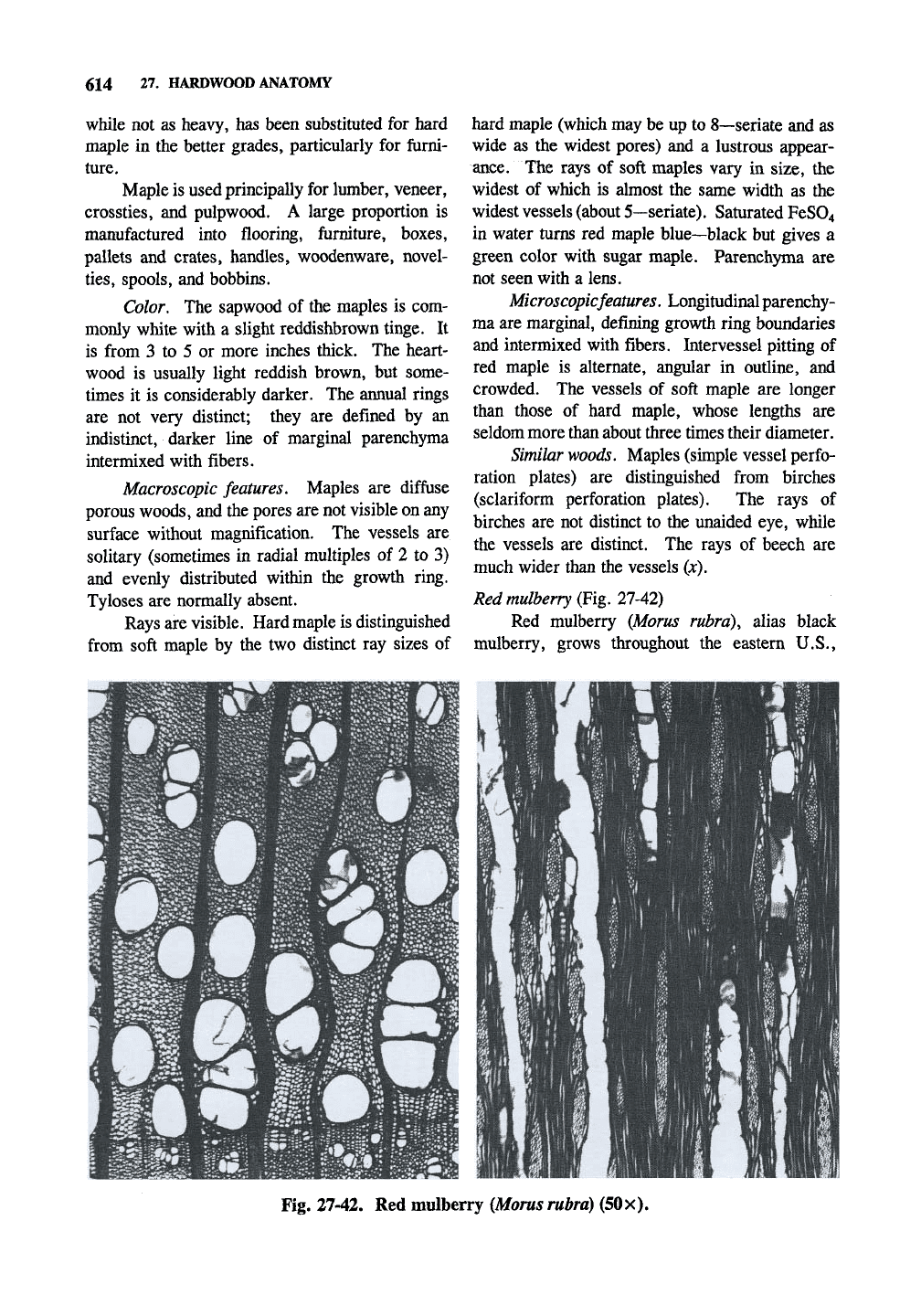
614 27. HARDWOOD ANATOMY
while not as heavy, has been substituted for hard
maple in the better grades, particularly for furni-
ture.
Maple is used principally for lumber, veneer,
crossties, and pulpwood. A large proportion is
manufactured into flooring, furniture, boxes,
pallets and crates, handles, woodenware, novel-
ties,
spools, and bobbins.
Color. The sapwood of the maples is com-
monly white with a slight reddishbrown tinge. It
is from 3 to 5 or more inches thick. The heart-
wood is usually light reddish brown, but some-
times it is considerably darker. The annual rings
are not very distinct; they are defined by an
indistinct, darker line of marginal parenchyma
intermixed with fibers.
Macroscopic features. Maples are diffuse
porous woods, and the pores are not visible on any
surface without magnification. The vessels are
solitary (sometimes in radial muhiples of 2 to 3)
and evenly distributed within the growth ring.
Tyloses are normally absent.
Rays are visible. Hard maple is distinguished
from soft maple by the two distinct ray sizes of
hard maple (which may be up to 8—seriate and as
wide as the widest pores) and a lustrous appear-
ance.
The rays of soft maples vary in size, the
widest of which is almost the same width as the
widest vessels (about 5—seriate). Saturated FeS04
in water turns red maple blue—black but gives a
green color with sugar maple. Parenchyma are
not seen with a lens.
Microscopic features. Longitudinal parenchy-
ma are marginal, defining growth ring boundaries
and intermixed with fibers. Intervessel pitting of
red maple is alternate, angular in outline, and
crowded. The vessels of soft maple are longer
than those of hard maple, whose lengths are
seldom more than about three times their diameter.
Similar
woods.
Maples (simple vessel perfo-
ration plates) are distinguished from birches
(sclariform perforation plates). The rays of
birches are not distinct to the unaided eye, while
the vessels are distinct. The rays of beech are
much wider than the vessels (x).
Red
mulberry
(Fig. 27-42)
Red mulberry (Morus rubra), alias black
mulberry, grows throughout the eastern U.S.,
Fig. 27-42. Red mulberry (Moms
rubra)
(50x).
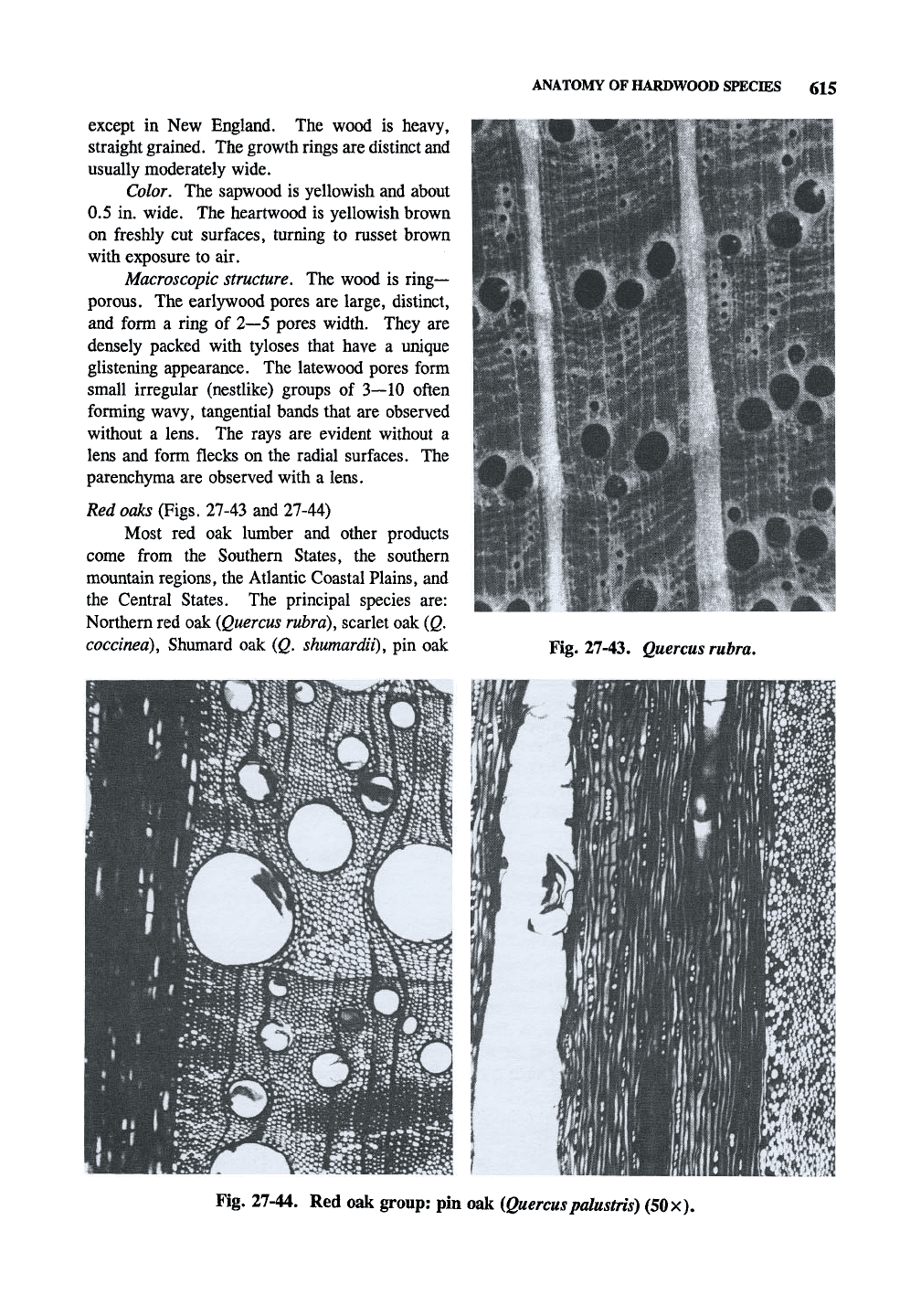
ANATOMY OF HARDWOOD SPECIES 615
except in New England. The wood is heavy,
straight grained. The growth rings are distinct and
usually moderately wide.
Color. The sapwood is yellowish and about
0.5 in. wide. The heartwood is yellowish brown
on freshly cut surfaces, turning to russet brown
with exposure to air.
Macroscopic structure. The wood is ring-
porous. The earlywood pores are large, distinct,
and form a ring of 2—5 pores width. They are
densely packed with tyloses that have a unique
glistening appearance. The latewood pores form
small irregular (nestlike) groups of 3—10 often
forming wavy, tangential bands that are observed
without a lens. The rays are evident without a
lens and form flecks on the radial surfaces. The
parenchyma are observed with a lens.
Red oaks (Figs. 27-43 and 27-44)
Most red oak lumber and other products
come from the Southern States, the southern
mountain regions, the Atlantic Coastal Plains, and
the Central States. The principal species are:
Northern red oak
{Quercus
rubra), scarlet oak (Q.
coccinea),
Shumard oak {Q. shumardii), pin oak
Fig. 27-43.
Quercus
rubra.
Fig. 27-44. Red oak group: pin oak (Quercuspalustris) (50
x).
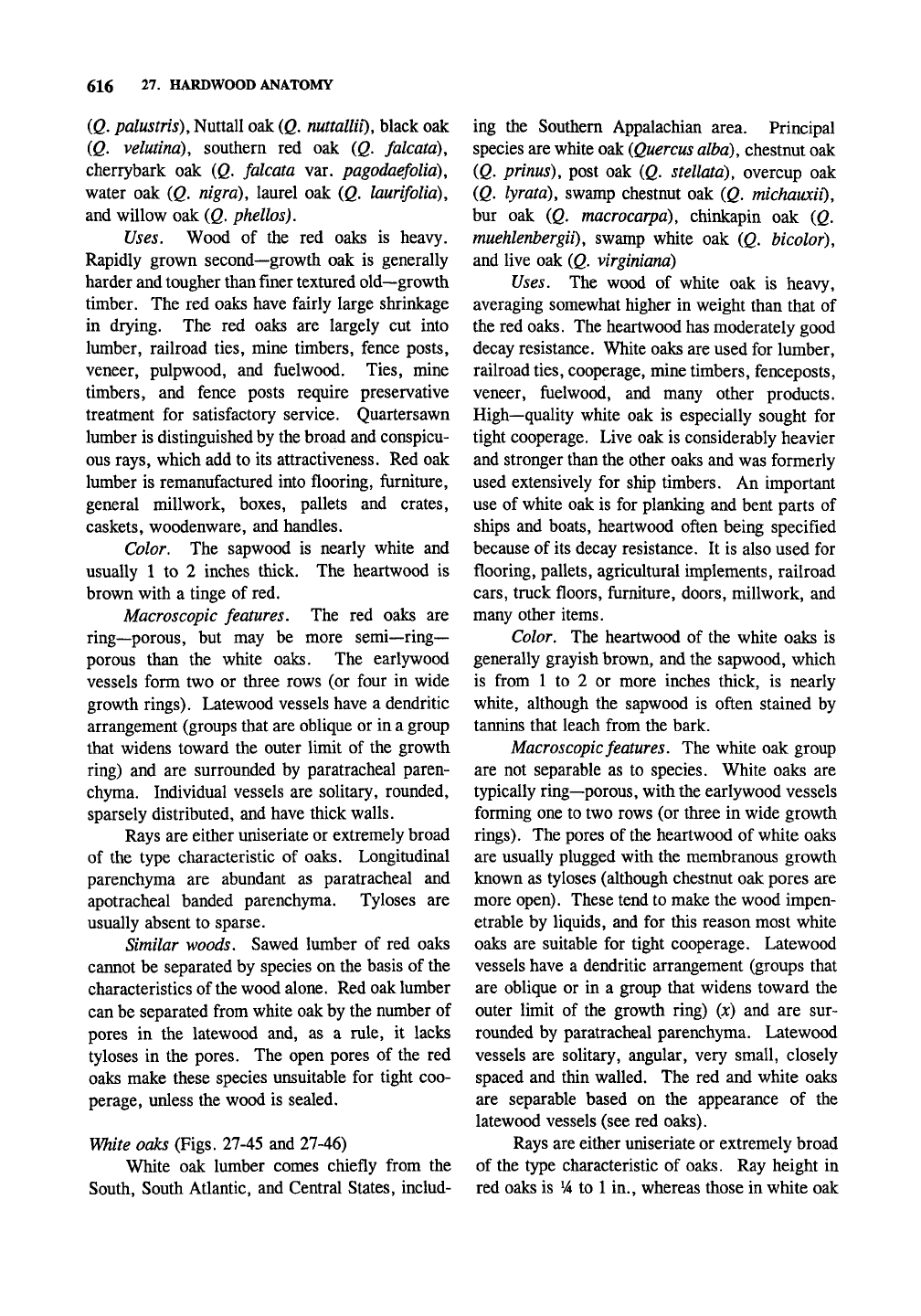
616 27. HARDWOOD ANATOMY
(Q, palustris), Nuttall oak
(Q.
nuttallii), black oak
{Q, velutina), southern red oak {Q. falcata),
cherrybark oak (Q. falcata var. pagodaefolia),
water oak (Q. nigra), laurel oak (Q. laurifolia),
and willow oak
{Q,
phellos).
Uses, Wood of the red oaks is heavy.
Rapidly grown second—growth oak is generally
harder and tougher than finer textured old—growth
timber. The red oaks have fairly large shrinkage
in drying. The red oaks are largely cut into
lumber, railroad ties, mine timbers, fence posts,
veneer, pulpwood, and fuelwood. Ties, mine
timbers, and fence posts require preservative
treatment for satisfactory service. Quartersawn
lumber is distinguished by the broad and conspicu-
ous rays, which add to its attractiveness. Red oak
lumber is remanufactured into flooring, furniture,
general millwork, boxes, pallets and crates,
caskets, woodenware, and handles.
Color. The sapwood is nearly white and
usually 1 to 2 inches thick. The heartwood is
brown with a tinge of red.
Macroscopic features. The red oaks are
ring—porous, but may be more semi—ring-
porous than the white oaks. The earlywood
vessels form two or three rows (or four in wide
growth rings). Latewood vessels have a dendritic
arrangement (groups that are oblique or in a group
that widens toward the outer limit of the growth
ring) and are surrounded by paratracheal paren-
chyma. Individual vessels are solitary, rounded,
sparsely distributed, and have thick walls.
Rays are either uniseriate or extremely broad
of the type characteristic of oaks. Longitudinal
parenchyma are abundant as paratracheal and
apotracheal banded parenchyma. Tyloses are
usually absent to sparse.
Similar woods. Sawed lumber of red oaks
cannot be separated by species on the basis of the
characteristics of the wood alone. Red oak lumber
can be separated from white oak by the number of
pores in the latewood and, as a rule, it lacks
tyloses in the pores. The open pores of the red
oaks make these species unsuitable for tight coo-
perage, unless the wood is sealed.
Wiite oaks (Figs. 27-45 and 27-46)
White oak lumber comes chiefly from the
South, South Atlantic, and Central States, includ-
ing the Southern Appalachian area. Principal
species are white oak
(Quercus
alba), chestnut oak
{Q. prims), post oak (Q. stellata), overcup oak
{Q. lyrata), swamp chestnut oak {Q. michauxii),
bur oak (Q. macrocarpa), chinkapin oak (Q.
muehlenbergii), swamp white oak {Q. bicolor),
and live oak
{Q.
virginiana)
Uses. The wood of white oak is heavy,
averaging somewhat higher in weight than that of
the red oaks. The heartwood has moderately good
decay resistance. White oaks are used for lumber,
railroad ties, cooperage, mine timbers, fenceposts,
veneer, fuelwood, and many other products.
High—quality white oak is especially sought for
tight cooperage. Live oak is considerably heavier
and stronger than the other oaks and was formerly
used extensively for ship timbers. An important
use of white oak is for planking and bent parts of
ships and boats, heartwood often being specified
because of its decay resistance. It is also used for
flooring, pallets, agricultural implements, railroad
cars,
truck floors, ftirniture, doors, millwork, and
many other items.
Color. The heartwood of the white oaks is
generally grayish brown, and the sapwood, which
is from 1 to 2 or more inches thick, is nearly
white, although the sapwood is often stained by
tannins that leach from the bark.
Macroscopic features. The white oak group
are not separable as to species. White oaks are
typically ring—porous, with the earlywood vessels
forming one to two rows (or three in wide growth
rings).
The pores of the heartwood of white oaks
are usually plugged with the membranous growth
known as tyloses (although chestnut oak pores are
more open). These tend to make the wood impen-
etrable by liquids, and for this reason most white
oaks are suitable for tight cooperage. Latewood
vessels have a dendritic arrangement (groups that
are oblique or in a group that widens toward the
outer limit of the growth ring) (x) and are sur-
rounded by paratracheal parenchyma. Latewood
vessels are solitary, angular, very small, closely
spaced and thin walled. The red and white oaks
are separable based on the appearance of the
latewood vessels (see red oaks).
Rays are either uniseriate or extremely broad
of the type characteristic of oaks. Ray height in
red oaks is
V4
to 1 in., whereas those in white oak
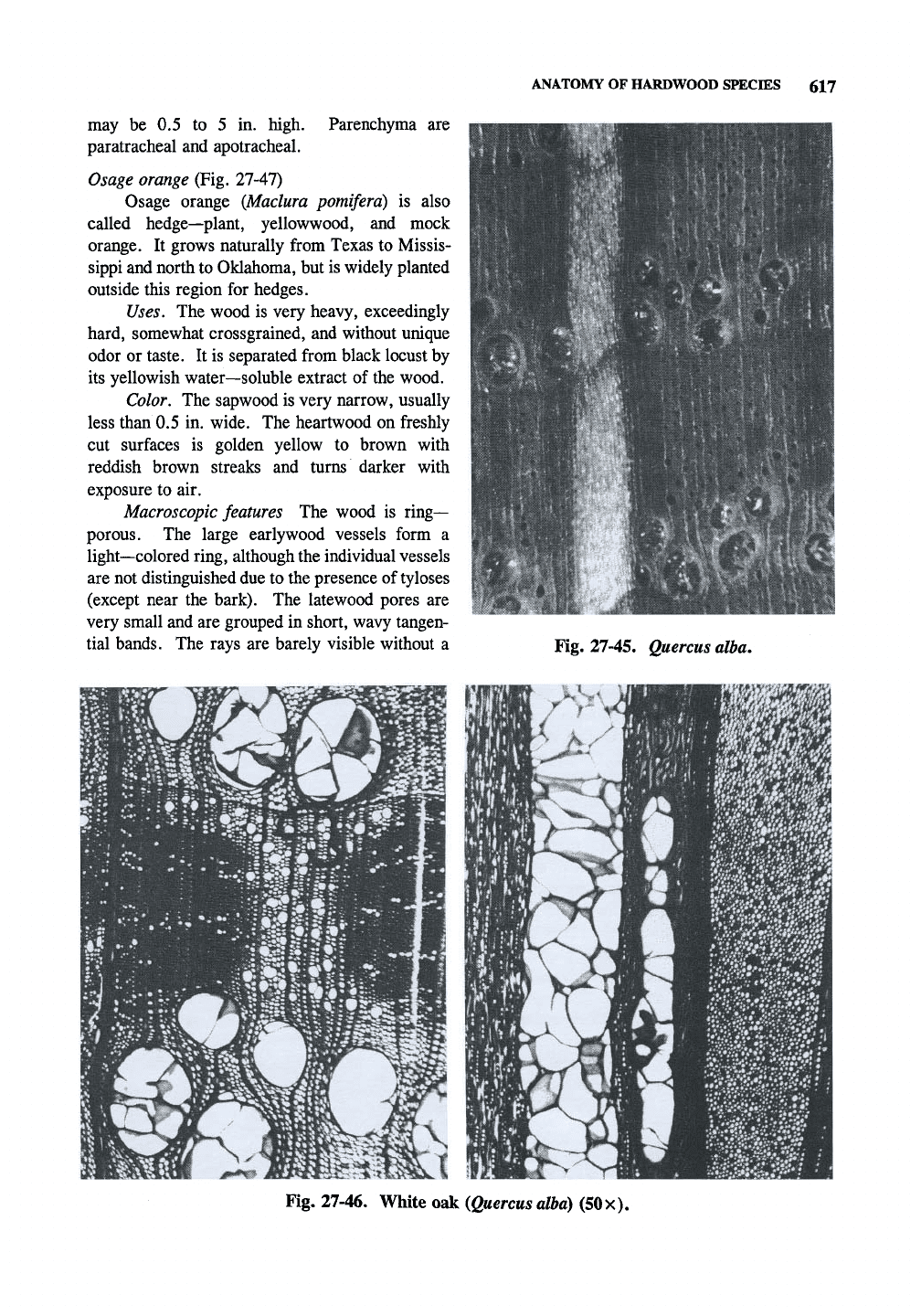
ANATOMY OF HARDWOOD SPECIES 617
may be 0.5 to 5 in. high,
paratracheal and apotracheal.
Parenchyma are
Osage orange (Fig. 27-47)
Osage orange {Madura pomifera) is also
called hedge—plant, yellowwood, and mock
orange. It grows naturally from Texas to Missis-
sippi and north to Oklahoma, but is widely planted
outside this region for hedges.
Uses. The wood is very heavy, exceedingly
hard, somewhat crossgrained, and without unique
odor or taste. It is separated from black locust by
its yellowish water—soluble extract of the wood.
Color. The sapwood is very narrow, usually
less than 0.5 in. wide. The heartwood on freshly
cut surfaces is golden yellow to brown with
reddish brown streaks and turns darker with
exposure to air.
Macroscopic features The wood is ring-
porous. The large early wood vessels form a
light—colored ring, although the individual vessels
are not distinguished due to the presence of tyloses
(except near the bark). The latewood pores are
very small and are grouped in short, wavy tangen-
tial bands. The rays are barely visible without a
Fig. 27-45.
Quercus
alba.
Fig. 27-46. White oak
{Q^ercus alba) (50
x).
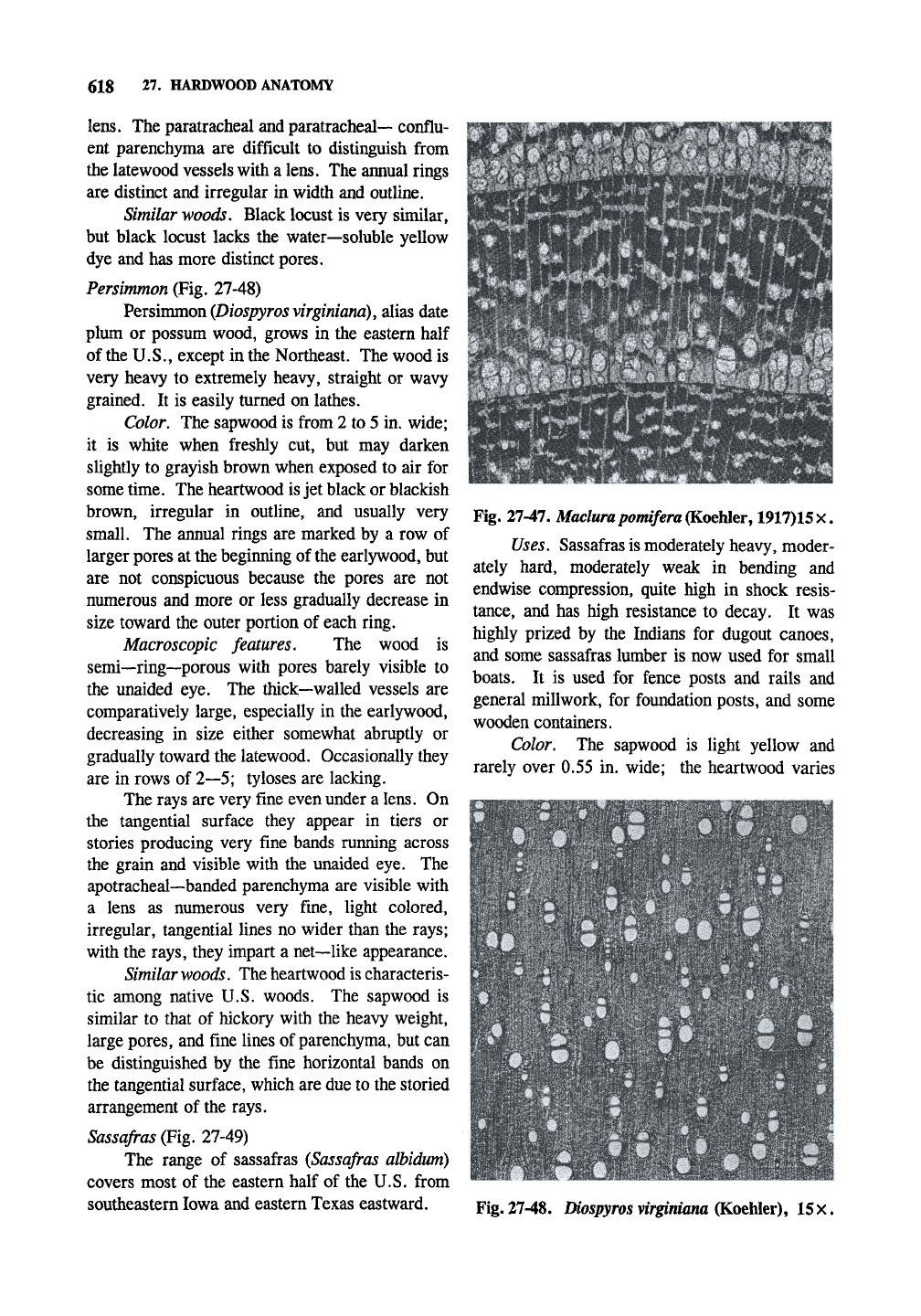
618 27. HARDWOOD ANATOMY
lens.
The paratracheal and paratracheal— conflu-
ent parenchyma are difficult to distinguish from
the latewood vessels with a lens. The annual rings
are distinct and irregular in width and outline.
Similar woods. Black locust is very similar,
but black locust lacks the water—soluble yellow
dye and has more distinct pores.
Persimmon (Fig. 27-48)
Persinmion
{Diospyros
virginiana),
alias date
plum or possum wood, grows in the eastern half
of the U.S., except in the Northeast. The wood is
very heavy to extremely heavy, straight or wavy
grained. It is easily turned on lathes.
Color, The sapwood is from 2 to 5 in. wide;
it is white when freshly cut, but may darken
slightly to grayish brown when exposed to air for
some time. The heartwood
is
jet black or blackish
brown, irregular in outline, and usually very
small. The annual rings are marked by a row of
larger pores at the beginning of
the
earlywood, but
are not conspicuous because the pores are not
numerous and more or less gradually decrease in
size toward the outer portion of each ring.
Macroscopic features. The wood is
semi—ring—porous with pores barely visible to
the unaided eye. The thick—walled vessels are
comparatively large, especially in the earlywood,
decreasing in size either somewhat abruptly or
gradually toward the latewood. Occasionally they
are in rows of
2—5;
tyloses are lacking.
The rays are very fme even under a lens. On
the tangential surface they appear in tiers or
stories producing very fme bands running across
the grain and visible with the unaided eye. The
apotracheal—banded parenchyma are visible with
a lens as numerous very fme, light colored,
irregular, tangential lines no wider than the rays;
with the rays, they impart a net—like appearance.
Similar
woods.
The heartwood is characteris-
tic among native U.S. woods. The sapwood is
similar to that of hickory with the heavy weight,
large pores, and fme lines of parenchyma, but can
be distinguished by the fme horizontal bands on
the tangential surface, which are due to the storied
arrangement of the rays.
Sassafras (Fig. 27-49)
The range of sassafras (Sassafras albidum)
covers most of the eastern half of the U.S. from
southeastern Iowa and eastern Texas eastward.
Mmmmm¥':
Fig. 27-47.
Maclurapomifera
(Koehler,
1917)15 X.
Uses. Sassafras is moderately heavy, moder-
ately hard, moderately weak in bending and
endwise compression, quite high in shock resis-
tance, and has high resistance to decay. It was
highly prized by the Indians for dugout canoes,
and some sassafras lumber is now used for small
boats.
It is used for fence posts and rails and
general millwork, for foundation posts, and some
wooden containers.
Color. The sapwood is light yellow and
rarely over 0.55 in. wide; the heartwood varies
Fig. 27-48. Diospyros virgimana (Koehler), 15 x.
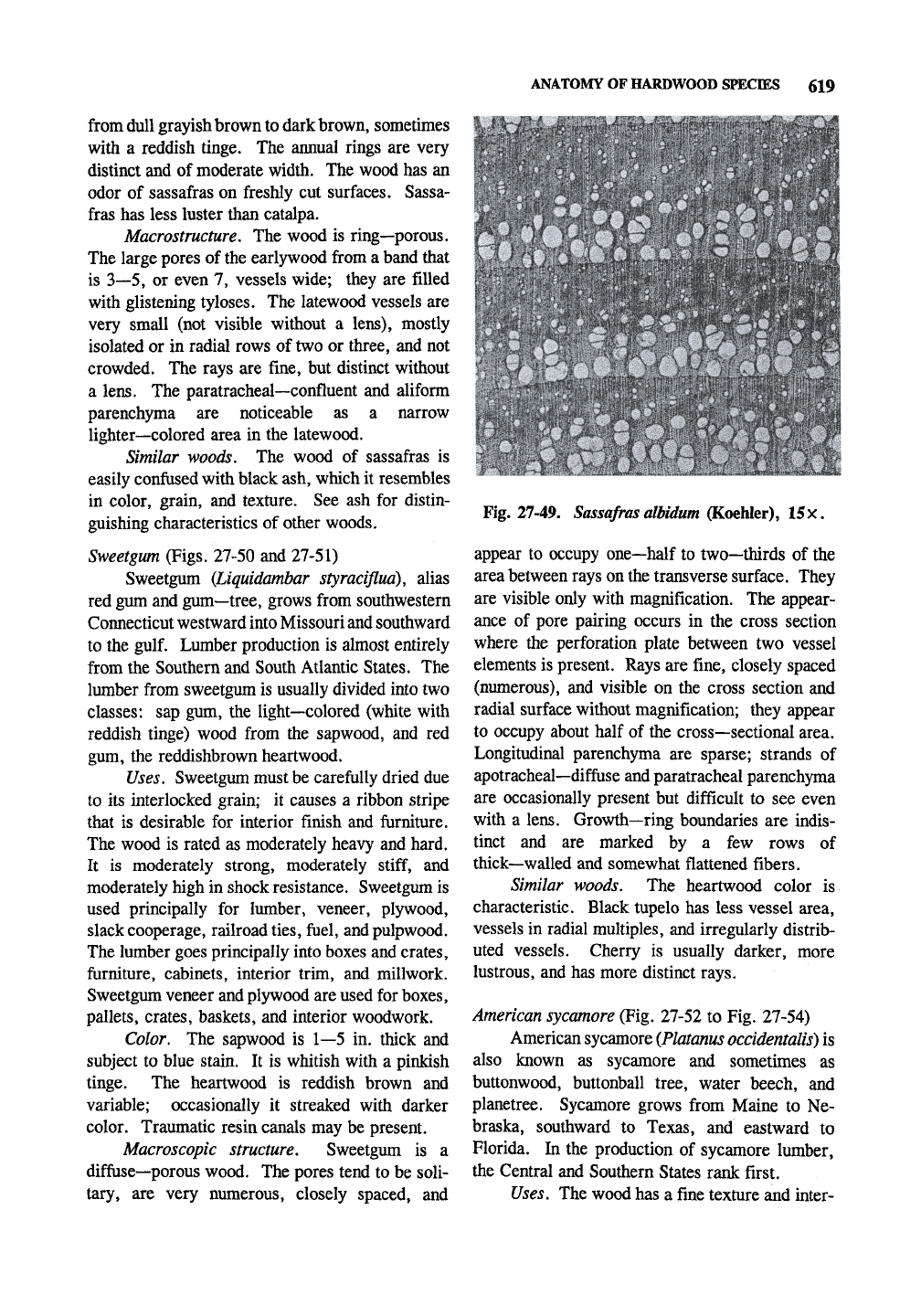
ANATOMY
OF
HARDWOOD SPECIES
619
from dull grayish brown to dark
brown,
sometimes
with
a
reddish tinge.
The
annual rings
are
very
distinct
and of
moderate width.
The
wood
has an
odor
of
sassafras
on
freshly
cut
surfaces. Sassa-
fras
has
less luster than catalpa.
Macrostructure,
The
wood
is
ring—porous.
The large pores
of
the earlywood from
a
band that
is
3—5, or
even
7,
vessels wide; they
are
filled
with glistening tyloses.
The
latewood vessels
are
very small
(not
visible without
a
lens), mostly
isolated
or in
radial rows
of
two
or
three,
and not
crowded.
The
rays
are
fine,
but
distinct without
a lens.
The
paratracheal—confluent
and
aliform
parenchyma
are
noticeable
as a
narrow
lighter—colored area
in the
latewood.
Similar woods.
The
wood
of
sassafras
is
easily confused with black ash, which
it
resembles
in color, grain,
and
texture.
See ash for
distin-
guishing characteristics
of
other woods.
Sweetgum (Figs. 27-50
and
27-51)
Sweetgum (Liquidambar styraciflua), alias
red gum
and
gum—tree, grows from southwestern
Connecticut westward into Missouri and southward
to
the gulf.
Limiber production
is
almost entirely
from
the
Southern
and
South Atlantic States.
The
lumber from sweetgum
is
usually divided into
two
classes:
sap gum, the
light—colored (white with
reddish tinge) wood from
the
sapwood,
and red
gum,
the
reddishbrown heartwood.
Uses. Sweetgum must be carefully dried
due
to
its
interlocked grain;
it
causes
a
ribbon stripe
that
is
desirable
for
interior finish
and
furniture.
The wood
is
rated
as
moderately heavy
and
hard.
It
is
moderately strong, moderately
stiff, and
moderately high
in
shock resistance. Sweetgum
is
used principally
for
lumber, veneer, plywood,
slack cooperage, railroad ties, fuel, andpulpwood.
The lumber goes principally into boxes and crates,
furniture, cabinets, interior trim,
and
millwork.
Sweetgum veneer and plywood are used
for
boxes,
pallets, crates, baskets,
and
interior woodwork.
Color.
The
sapwood
is 1—5 in.
thick
and
subject
to
blue stain.
It is
whitish with
a
pinkish
tinge.
The
heartwood
is
reddish brown
and
variable; occasionally
it
streaked with darker
color. Traumatic resin canals
may be
present.
Macroscopic structure. Sweetgxmi
is a
diffuse—porous wood.
The
pores tend
to be
soli-
tary,
are
very numerous, closely spaced,
and
Fig. 27-49.
Sassafras albidum
(Koehler), 15 x.
appear
to
occupy one—half
to
two—thirds
of the
area between rays on the transverse surface. They
are visible only with magnification.
The
appear-
ance
of
pore pairing occurs
in the
cross section
where
the
perforation plate between
two
vessel
elements
is
present. Rays
are
fine, closely spaced
(numerous),
and
visible
on the
cross section
and
radial surface without magnification; they appear
to occupy about half
of the
cross—sectional area.
Longitudinal parenchyma
are
sparse; strands
of
apotracheal—diffuse and paratracheal parenchyma
are occasionally present
but
difficult
to see
even
with
a
lens. Growth—ring boundaries
are
indis-
tinct
and are
marked
by a few
rows
of
thick—walled
and
somewhat flattened fibers.
Similar woods.
The
heartwood color
is
characteristic. Black tupelo
has
less vessel area,
vessels
in
radial multiples,
and
irregularly distrib-
uted vessels. Cherry
is
usually darker, more
lustrous,
and has
more distinct rays.
American sycamore (Fig. 27-52
to Fig.
27-54)
American sycamore
(Platanus occidentalis)
is
also known
as
sycamore
and
sometimes
as
buttonwood, buttonball tree, water beech,
and
planetree. Sycamore grows from Maine
to Ne-
braska, southward
to
Texas,
and
eastward
to
Florida.
In the
production
of
sycamore lumber,
the Central
and
Southern States rank first.
Uses.
The
wood has
a
fine texture
and
inter-
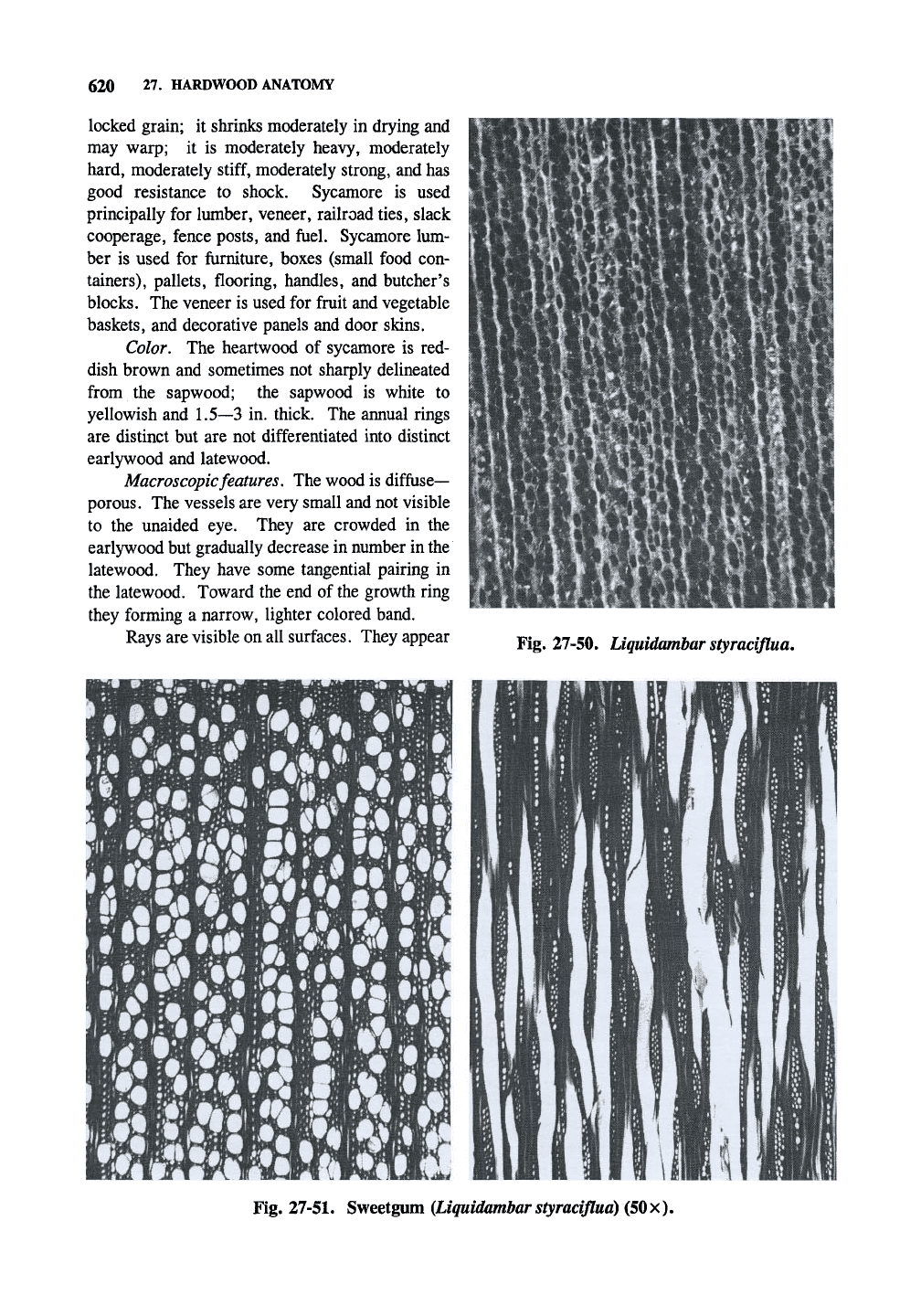
620 27. HARDWOOD ANATOMY
locked grain; it shrinks moderately in drying and
may warp; it is moderately heavy, moderately
hard, moderately
stiff,
moderately strong, and has
good resistance to shock. Sycamore is used
principally for lumber, veneer, railroad ties, slack
cooperage, fence posts, and fuel. Sycamore lum-
ber is used for furniture, boxes (small food con-
tainers), pallets, flooring, handles, and butcher's
blocks. The veneer is used for fruit and vegetable
baskets, and decorative panels and door skins.
Color. The heartwood of sycamore is red-
dish brown and sometimes not sharply delineated
from the sapwood; the sapwood is white to
yellowish and 1.5—3 in. thick. The annual rings
are distinct but are not differentiated into distinct
earlywood and latewood.
Macroscopic features. The wood is diffuse-
porous. The vessels are very small and not visible
to the unaided eye. They are crowded in the
earlywood but gradually decrease in number in the
latewood. They have some tangential pairing in
the latewood. Toward the end of the growth ring
they forming a narrow, lighter colored band.
Rays are visible on all surfaces. They appear
Fig. 27-50. Liquidambar styraciflua.
Fig.
27-51.
Sweetgum (Liquidambar styraciflua) (50X).

ANATOMY OF HARDWOOD SPECIES 621
Fig. 27-52. Platanus occidentalis.
Fig. 27-53. Platanus
occidentalis,
rview, 50 x.
Fig. 27-54. American sycamore
(Platanus occidentalis)
(50x).
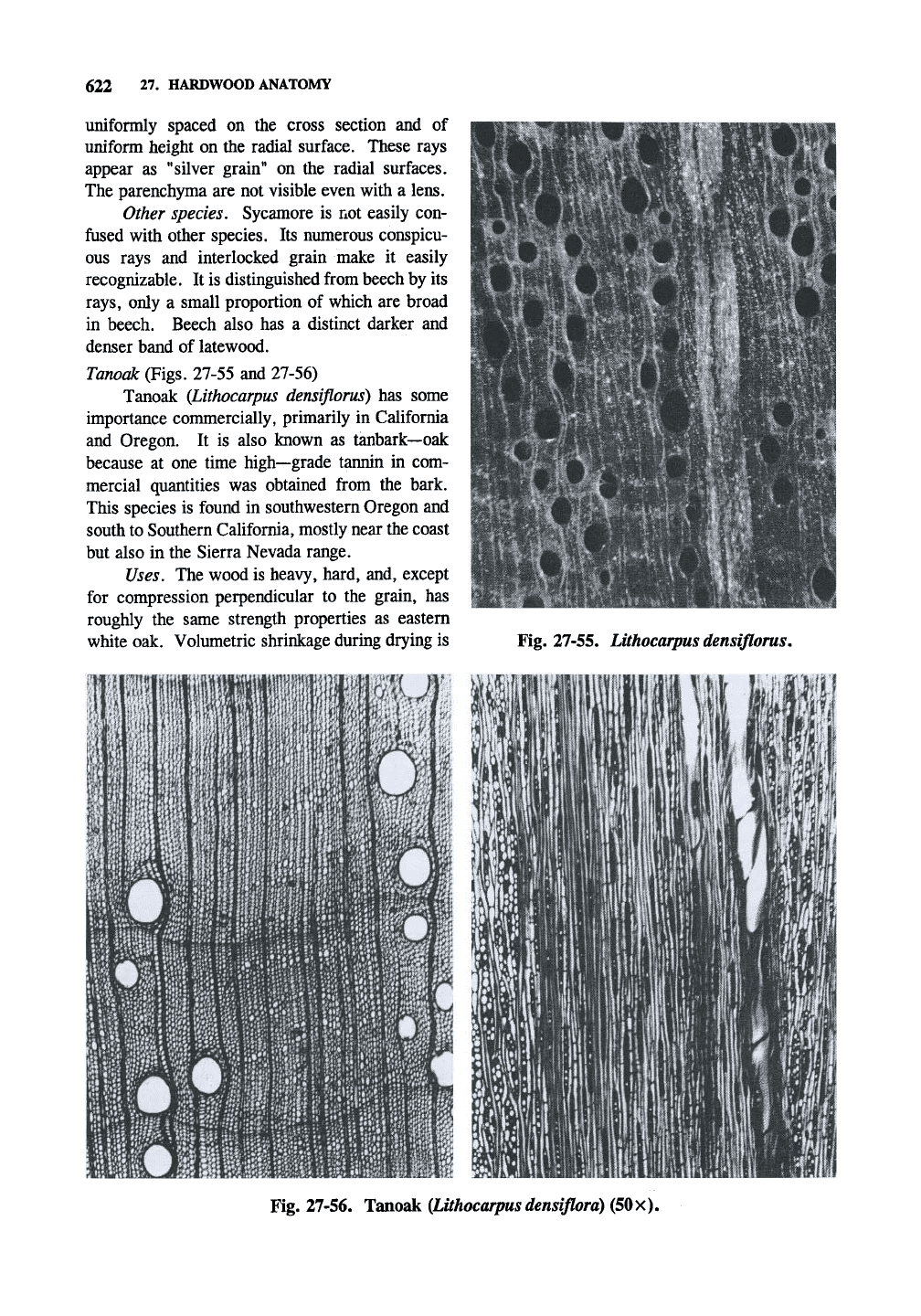
622 27. HARDWOOD ANATOMY
uniformly spaced on the cross section and of
uniform height on the radial surface. These rays
appear as "silver grain" on the radial surfaces.
The parenchyma are not visible even with a lens.
Other species. Sycamore is not easily con-
fused with other species. Its numerous conspicu-
ous rays and interlocked grain make it easily
recognizable. It is distinguished from beech by its
rays,
only a small proportion of which are broad
in beech. Beech also has a distinct darker and
denser band of latewood.
Tanoak (Figs. 27-55 and 27-56)
Tanoak {Lithocarpus densiflorus) has some
importance commercially, primarily in California
and Oregon. It is also known as tanbark~oak
because at one time high—grade tannin in com-
mercial quantities was obtained from the bark.
This species is found in southwestern Oregon and
south to Southern California, mostly near the coast
but also in the Sierra Nevada range.
Uses. The wood is heavy, hard, and, except
for compression perpendicular to the grain, has
roughly the same strength properties as eastern
white oak. Volumetric shrinkage during drying is
Fig. 27-55.
Lithocarpus
densiflorus.
Fig. 27-56. Tanoak
{Lithocarpus
densiflora) (50x).
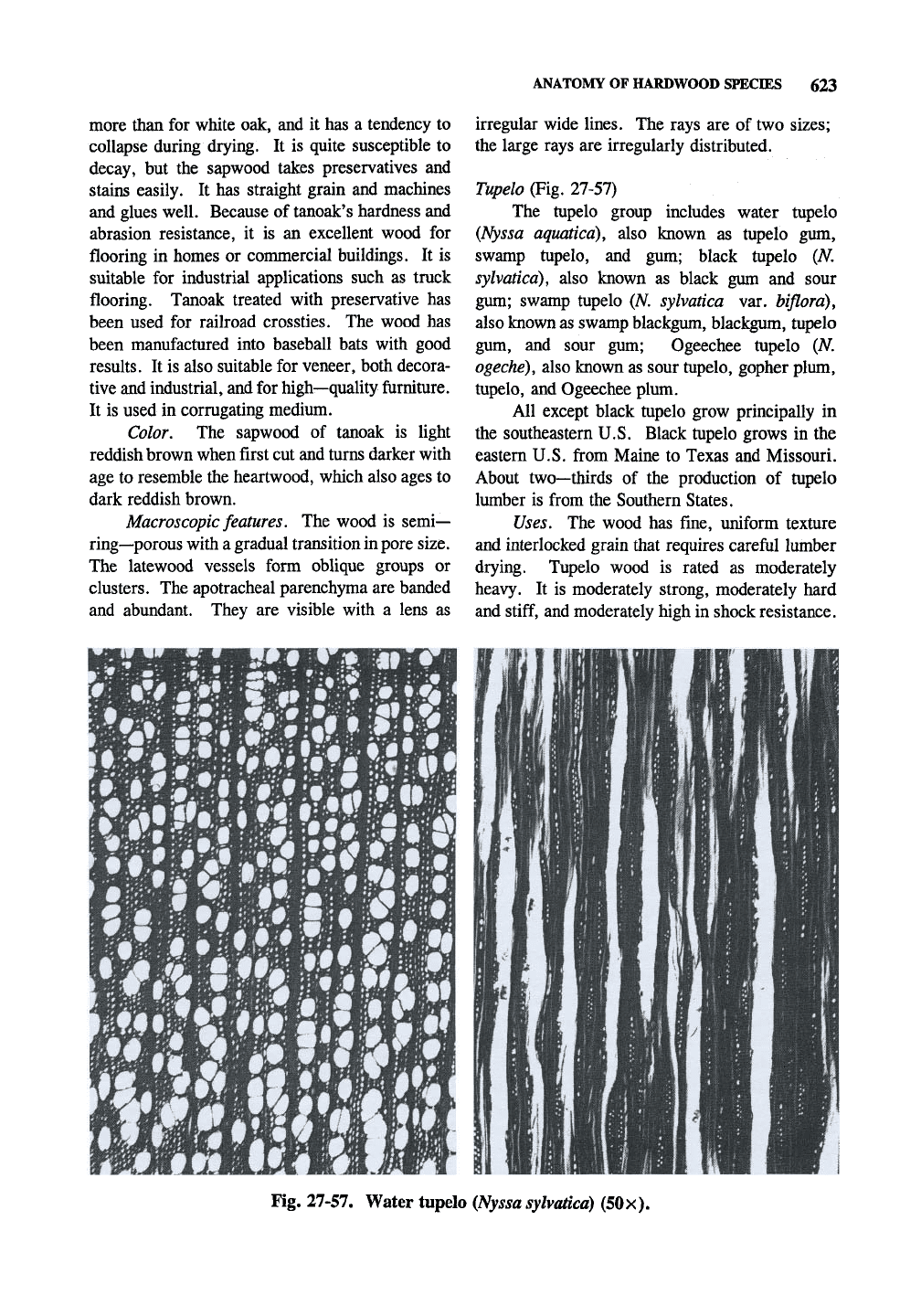
ANATOMY OF HARDWOOD SPECIES 623
more than for white oak, and it has a tendency to
collapse during drying. It is quite susceptible to
decay, but the sapwood takes preservatives and
stains easily. It has straight grain and machines
and glues well. Because of tanoak's hardness and
abrasion resistance, it is an excellent wood for
flooring in homes or commercial buildings. It is
suitable for industrial applications such as truck
flooring. Tanoak treated with preservative has
been used for railroad crossties. The wood has
been manufactured into baseball bats with good
results. It is also suitable for veneer, botii decora-
tive and industrial, and for high—quality furniture.
It is used in corrugating medium.
Color. The sapwood of tanoak is light
reddish brown when first cut and turns darker with
age to resemble the heartwood, which also ages to
dark reddish brown.
Macroscopic
features. The wood is semi-
ring—porous with a gradual transition in pore size.
The latewood vessels form oblique groups or
clusters. The apotracheal parenchyma are banded
and abundant. They are visible with a lens as
irregular wide lines. The rays are of two sizes;
the large rays are irregularly distributed.
Tupelo (Fig. 27-57)
The tupelo group includes water tupelo
(Nyssa aquatica), also known as tupelo gum,
swamp tupelo, and gum; black tupelo (N.
sylvatica),
also known as black gum and sour
gum; swamp tupelo (N. sylvatica var. biflora),
also known
as
swamp blackgum, blackgum, tupelo
gum, and sour gum; Ogeechee tupelo (A^.
ogeche),
also known as sour tupelo, gopher plum,
tupelo, and Ogeechee plum.
All except black tupelo grow principally in
the southeastern U.S. Black tupelo grows in the
eastern U.S. from Maine to Texas and Missouri.
About two—thirds of the production of tupelo
lumber is from the Southern States.
Uses. The wood has fine, uniform texture
and interlocked grain that requires careful lumber
drying. Tupelo wood is rated as moderately
heavy. It is moderately strong, moderately hard
and
stiff,
and moderately high in shock resistance.
Fig. 27-57. Water tupelo
{Nyssa sylvatica)
(50x).
